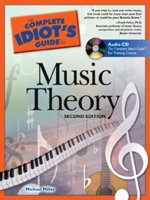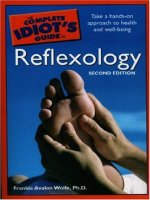ebook education the complete idiots guide to learning sign language
Bạn đang xem bản rút gọn của tài liệu. Xem và tải ngay bản đầy đủ của tài liệu tại đây (9.98 MB, 479 trang )
Page i
Learning Sign Language
by Susan Shelly and Jim Schneck
A Division of Macmillan General Reference
A Simon & Schuster Macmillan Company
1633 Broadway, New York, NY 10019
inside front cover
DEAR READER
fold-out back cover
THE COMPLETE IDIOT'S REFERENCE CARDPage ii
To the brave, Deaf children who kept on signing through the age of oralism, despite the taunts
and punishments to which they were subjected.
©1998 by Susan Shelly and Jim Schneck
All rights reserved. No part of this book shall be reproduced, stored in a retrieval system, or
transmitted by any means, electronic, mechanical, photocopying, recording, or otherwise, without
written permission from the publisher. No patent liability is assumed with respect to the use of the
information contained herein. Although every precaution has been taken in the preparation of this
book, the publisher and author assume no responsibility for errors or omissions. Neither is any
liability assumed for damages resulting from the use of information contained herein. For
information, address Alpha Books, 1633 Broadway, 7th Floor, New York, NY 10019-6785.
THE COMPLETE IDIOT'S GUIDE TO and design are trademarks of Prentice-Hall, Inc.
Macmillan Publishing books may be purchased for business or sales promotional use. For
information please write: Special Markets Department, Macmillan Publishing USA, 1633
Broadway, New York, NY 10019.
International Standard Book Number: 0-02-862388-6
Library of Congress Catalog Card Number: 98-85701
00 99 8 7 6 5 4 3
Interpretation of the printing code: the rightmost number of the first series of numbers is the year
of the book's printing; the rightmost number of the second series of numbers is the number of the
book's printing. For example, a printing code of 98-1 shows that the first printing occurred in
1998.
Printed in the United States of America
Note: This publication contains the opinions and ideas of its author. It is intended to provide
helpful and informative material on the subject matter covered. It is sold with the understanding
that the author and publisher are not engaged in rendering professional services in the book. If the
reader requires personal assistance or advice, a competent professional should be consulted.
The author and publisher specifically disclaim any responsibility for any liability, loss or risk,
personal or otherwise, which is incurred as a consequence, directly or indirectly, of the use and
application of any of the contents of this book.
Page iii
ALPHA DEVELOPMENT TEAM
Publisher
Kathy Nebenhaus
Editorial Director
Gary M. Krebs
Managing Editor
Bob Shuman
Marketing Brand Manager
Felice Primeau
Senior Editor
Nancy Mikhail
Development Editors
Phil Kitchel
Jennifer Perillo
Amy Zavatto
Assistant Editor
Maureen Horn
PRODUCTION TEAM
Development Editor
Nancy Warner
Production Editor
Robyn Burnett
Copy Editor
Lynn Northrup
Cover Designer
Mike Freeland
Photo Editor
Richard H. Fox
Illustrator
Jody P. Schaeffer
Designer
Dan Armstrong
Indexer
Nadia Ibrahim
Layout/Proofreading
Angela Calvert
Megan Wade
Page iv
CONTENTS AT A GLANCE
Part 1: Let's Start at the Very Beginning
1
1 So, You Want to Learn to Sign
Let us introduce you to American Sign Language.
3
2 Who Ever Thought of This Language?
How ASL came to be, despite widespread efforts to stop it.
15
3 But, Is It Really a Language?
Is a Language without words really a-language? You bet.
29
4 I'll Never Get This—Will I?
Suggestions and tips for learning and using ASL.
41
Part 2: Preparing to Learn ASL
49
5 The Four Parts of a Sign
No sign is complete without four, basic components.
51
6 It's the Little Things That Make All the Difference
There's much more to ASL than hand motions.
59
7 Variations On a Basic Sign
There are various ways to clarify or classify a sign.
69
8 ABCs and So Forth
Learn the American Manual Alphabet and the importance of
fingerspelling.
77
9 1—2—3s
You'll learn to count to a million in this chapter.
85
Part 3: Signs You'll Need to Know
97
10 The Family Circle and Beyond
Family relationships can sometimes be rocky, but it's still
good to know the signs for the people you love.
99
11 Home and Other Hangouts
Find out what makes the homes of Deaf people special, and
the signs for common things found in homes.
109
12 It's Off to Work (or School) We Go
Knowing these signs will help you earn that promotion or
advance to the head of the class.
119
13 Pets and Other Beasts
If it barks, roars, swims, or grows, we'll show you how to sign
it.
131
Page v
14 Anybody Hungry?
Next time you want a burger with fries, you'll be able to order
it in ASL.
139
15 Clothing Basics
Learn the signs for everything from basics to bangles.
149
16 Clubs, Celebrations, and Occasions
You'll be the belle of the ball once you've learned these signs
for special events and etiquette.
155
17 Weather or Not
Weather affects us all every day; let's look at the signs for
those climatic considerations.
163
18 Don't Know Much About Geography
Even if you're not good with directions, you'll be able to sign
like you are.
171
Part 4: More Signs You'll Need to Know
181
19 Time on Your Hands
This chapter covers everything from minutes to years.
183
20 In Sickness and in Health
Learn about the difficulties Deaf people encounter in
hospitals, and signs for the parts of the body, illnesses, and
emotions.
191
21 How Would You Describe That?
Blue or green, tall or short, nice or mean, big or
small—you'll learn how to describe it in sign language.
201
22 Crime and Punishment
Learn about difficulties Deaf people experience within the
legal system, and signs for things related to law and order.
209
23 Come and Worship
Find out why religion is important in the history of ASL and
learn some signs associated with religion and spirituality.
217
Part 5: Fine-Tuning
225
24 We're Not Done Yet!
It's time to look at those fun topics like prepositions and
conjunctions.
227
25 Ask Me a Question
There are two basic types of questions in ASL; we'll show you
how to sign both of them.
237
Page vi
26 Use It or Lose It
Tips for advancing in ASL, and a look into some of the
subtleties and humor of the language.
243
Appendix A Resources for the Deaf and for Families and
Friends
249
Appendix B “Did You Know That…”
255
Glossary
257
Index
263
Page vii
CONTENTS
Part 1: Let's Start at the Very Beginning
1
1 So, You Want to Learn to Sign 3
What's It All About? It Depends on Who You Ask
4
A Show of Hands, Please
5
ASL as a Second Language
7
ASL in Sports
7
Poetry in Motion
8
It Ain't the Only Game in Town
9
High-Tech Breakthroughs
11
The Least You Need to Know
12
2 Who Ever Thought of This Language? 15
How Does Deafness Occur?
16
Prenatal Causes of Hearing Loss
16
Childhood Causes of Deafness and Hearing Loss
17
Inherited Causes of Deafness
17
Hearing Loss in Adults
18
Drug-Induced Hearing Loss
18
Misconceptions About Deafness and Deaf People
19
Talk About Being Paranoid!
19
Oppression of Deaf People
20
Early Efforts at Educating Deaf People
22
The Great Debate Begins
22
The Great Debate Continues
23
From France and Germany to the U.S.A.
24
Doing What Comes Naturally
25
Uh-Oh, Here Comes Trouble
26
From Bad to Worse
26
The Comeback of ASL
26
The Least You Need to Know
27
3 But, Is It Really a Language? 29
What's In a Word?
30
What's So Special About ASL?
31
When Learning the Language is Delayed
32
Professional Advice Can Help—or Hurt
33
Page viii
Signals in the Air
34
Call Them Accents
35
It's More Than Just a Language, Man
36
Coming Home
36
The Revolution
37
The Least You Need to Know
39
4 I'll Never Get This—Will I? 41
What Will It Take?
42
Using the Dictionary
43
Siglish
44
Sim-Com
44
Not by Book Alone
45
Helping Yourself
45
Practice Makes Perfect—Well, Almost
47
The Least You Need to Know
48
Part 2: Preparing to Learn ASL
49
5 The Four Parts of a Sign 51
The Main Components
51
Is That a “B,” a “5,” or a “Claw”?
52
Location, Location, Location
54
Here, There, and Everywhere
55
Stationary Signs
55
Speed and Intensity
56
Up or Down, Right or Left?
57
The Least You Need to Know
57
6 It's the Little Things That Make All the Difference 59
To Right, or Not to Right?
60
In Your Face
60
Facial Expression
60
Eye Contact
63
Body Language
64
Are We Signing the Same Language Here?
65
Sign Variation
66
Get With It, Mom
67
The Least You Need to Know
67
Page ix
7 Variations On a Basic Sign 69
Gender Rules
70
Signs for All People
70
Compound Signs
71
Could It Mean Anything Else?
72
A Bit of Clarification, Please
73
Modified Signs
74
Whose Car? Or Is It Cars?
75
Possession
75
Plurals
75
The Least You Need to Know
76
8 ABCs and So Forth 77
The American Manual Alphabet
78
Other Signed Alphabets
80
When to Use Finger Spelling (and When Not to)
81
Doing It Right
82
The Least You Need to Know
83
9 1—2—3s 85
Numbers From 1–9
86
10–99 and Counting
87
Oddballs
91
Dollars and Cents
92
Addresses and Phone Numbers
94
Fractions
94
The Least You Need to Know
95
Part 3: Signs You'll Need to Know
97
10 The Family Circle and Beyond 99
It's a Family Affair
100
Mom, Dad, Sis, and Bro
101
They Call You What?
104
Good Buddies and Others
105
The Least You Need to Know
107
Page x
11 Home and Other Hangouts 109
Our Home Is Our Castle
110
A Day at the Beach
114
Places That You Go Each Day
117
The Least You Need to Know
117
12 It's Off to Work (or School) We Go 119
Vocations
120
Things You Do and Use at Work
123
The Great Halls of Learning
124
The Least You Need to Know
129
13 Pets and Other Beasts 131
Hearing Ear Dogs
132
Domestic Animals
133
Wild Things
134
Swimmin' Things
136
Plants and Flowers
136
The Least You Need to Know
137
14 Anybody Hungry? 139
Let's Stay In Tonight
140
Let's Go Out Tonight
143
We're Out of Milk Again!
145
The Least You Need to Know
148
15 Clothing Basics 149
Just the Basics
150
Outerwear
152
Unmentionables
153
Accessories
153
The Least You Need to Know
154
16 Clubs, Celebrations, and Occasions 155
Deaf Clubs
156
Birthday Parties
157
Weddings
158
Page xi
Holidays
159
Thanks, I'd Love to Join You
160
The Least You Need to Know
162
17 Weather or Not 163
Climatic Considerations
164
Natural Phenomena
166
To Everything There Is a Season
168
The Least You Need to Know
169
18 Don't Know Much About Geography 171
World-Wide Organizations
172
Which Way to Go?
173
Where in the World Are You?
175
States of the Union
177
Is That a Fiord or a Peninsula?
177
The Least You Need to Know
179
Part 4: More Signs You'll Need to Know
181
19 Time on Your Hands 183
Time for ASL
184
Hours and Minutes
184
The Days, They Pass So Quickly Now
186
From May to December
189
And the Years Keep on Rolling by
189
The Least You Need to Know
190
20 In Sickness and in Health 191
Body Parts
192
Medical Terms
194
Medical Conditions
196
Emotions
197
The Least You Need to Know
199
Page xii
21 How Would You Describe That? 201
Where Does the Adjective Go?
202
It's a Colorful World
202
Things That (some) People Are
204
Size Matters
205
Personal Qualities on the Inside
206
The Least You Need to Know
208
22 Crime and Punishment 209
Pull Over!
210
Order in the Court
210
Keeping the Peace
211
Lock 'Em Up!
212
Somebody Call My Lawyer
214
The Least You Need to Know
215
23 Come and Worship 217
Thank You for Your Support
218
Where We Go to Pray
219
Spirituality
220
All God's Children
223
The Least You Need to Know
223
Part 5: Fine-Tuning
225
24 We're Not Done Yet! 227
Word Order: Is It a Tall Tree or a Tree Tall?
228
Not! Using Negatives in ASL
229
Pronouns: Is Everyone Accounted for?
230
Prepositions and Conjunctions
233
The Least You Need to Know
235
25 Ask Me a Question 237
Could You Repeat the Question?
238
Is That a Yes or a No?
239
Who, What, When, Where, Why, and How?
239
Let Your Face Ask the Question
241
The Least You Need to Know
241
Page xiii
26 Use It or Lose It 243
Can You Relate?
244
Opportunities for Using ASL
244
Appreciating the Eloquence and Intricacies
245
Funny Stuff
246
Receiving Sign Language
248
A Closing Sign
248
The Least You Need to Know
248
A Resources for the Deaf and for Families and Friends
249
Better Hearing Institute 249
Children of Deaf Adults 249
DEAFPRIDE 249
DeafWorldWeb 250
Gallaudet Research Institute 250
Hear Now 250
International Association of Parents of the Deaf 250
Junior NAD Newsletter 250
Junior National Association of the Deaf Youth Programs 250
League for the Hard of Hearing 251
NAD Broadcaster (Newsletter) 251
National Association of the Deaf 251
National Center for Law and the Deaf 251
Real World Success 251
National Information Center on Deafness 252
National Research Register for Heredity Hearing Loss 252
Registry of Interpreters for the Deaf, Inc. 252
Sunset International Bible Institute 252
Telecommunications for the Deaf, Inc. 252
The National Theatre of the Deaf 253
World Recreation Association of the Deaf, Inc./USA 253
Self Help for Hard of Hearing People, Inc. 253
National Technical Institute for the Deaf 253
B “Did You Know That…”
255
Glossary
257
Index
263
Page xiv
FOREWORD
It has only been during the last couple of decades that American Sign Language, Deaf Studies,
and interpreter training programs have emerged as academic professions on the college/university
level. More recently, some high schools are offering American Sign Language as a language
option in their curriculum. It is also exciting to see that even the elementary and middle schools
incorporate some unit studies on American Sign Language, the Deaf community, and its culture.
With more Deaf children being mainstreamed in the regular classrooms and Deaf people at large
being able to access more services and programs through the use of interpreters everywhere, more
hearing people have become exposed to the Deaf community and their language: American Sign
Language (ASL). This kind of public exposure and the resulting media coverage have stirred up
increasing curiosity among hearing adults and children about the silent, intriguing language and
world of Deaf people.
As a CODA (Child of Deaf Adults) and as a professional academician who has been involved in
training students in American Sign Language and interpreting for almost three decades, I have
witnessed the explosion of information regarding Deaf people, their culture, American Sign
Language, and the profession of interpreting. Much of what still exists today (though to an
increasingly lesser degree) are the hurdles that Deaf people need to overcome surrounding
language barrier issues. It's incredible to think that sign language was unacceptable at one time,
but is now being embraced and even given official recognition through legislation in an increasing
number of states. This in itself is a major milestone. Giving credence to American Sign Language
places it on an equal par with languages of other cultures—and essentially implies acceptance of
the Deaf community at large.
I am pleased to be able to say that I personally know one of the authors, Jim Schneck. My
friendship with Jim took root when he was still a high school student learning American Sign
Language and was under the tutelage of my Deaf mother, Carrie Belle Dixon. Through the years,
I have had the opportunity to work professionally with Jim in the Deaf community, as interpreters,
and as colleagues on the university level, training students to learn ASL or become interpreters.
Jim is one of those rate, special people who have committed his life to the mission of working
with the Deaf mainstream in their struggle for education, individual rights, and accessibility.
If you are one of those people who have always wanted to learn American Sign Language, this
book will help you embark on such a journey. Unlike other texts that only contain the bare
presentation of signs, the authors of this book have provided you with practical information that is
vital and basic to understanding how to communicate with Deaf people.
Page xv
There is more than just learning signs. This book touches on topics that provide background and
an understanding of the Deaf community, their language, and culture. The authors share real life
experiences, both humorous and sad, that illustrate the struggles and encounters Deaf people face
in the hearing community.
If you are serious about learning to sign, and becoming acquainted with the community and
culture of Deaf people, this book will provide you with the basic knowledge and resources you
will need.
—KAREN B. TURNER, D. MIN.
ASSOCIATE PROFESSOR
AMERICAN SIGN LANGUAGE INTERPRETING AND TRANSLITERATING
DEGREE PROGRAM
THE UNIVERSITY OF AKRON
DR. KAREN B. TURNER IS ASSOCIATE PROFESSOR AND FOUNDER OF
THE AMERICAN SIGN LANGUAGE INTERPRETING AND
TRANSLITERATING DEGREE PROGRAM AT THE UNIVERSITY OF
AKRON. DR. TURNER IS ALSO A CODA (CHILD OF DEAF ADULTS). SHE
WAS NOMINATED FOR AN EMMY BY THE NATIONAL ACADEMY OF
TELEVISION ARTS AND SCIENCES FOR AKRON'S NEWSIGN
TELEVISION PROGRAM, WHICH HOLDS THE RECORD FOR THE
LONGEST INTERPRETED NEWS BROADCAST IN THE HISTORY
TELEVISION.
Page xvi
INTRODUCTION
Deaf people in this country have had a troubled, misunderstood, and overlooked history.
Largely controlled by hearing people who told them what and how to learn, how to communicate,
what jobs to expect, how to raise their children, and even who to marry, Deaf people for many
years accepted the labels they were given of “impaired” or “handicapped.” Many Deaf people
were put into institutions after they were diagnosed as mentally retarded. Some are still there.
Others were cloistered in their houses and never taught to communicate. Again, some are still
there. But Deaf people aren't putting up with these injustices any more. They're no longer letting
themselves be labeled, and they're not letting hearing folks tell them how to live.
The Deaf Revolution started quietly, then erupted in 1988, at Gallaudet University in Washington,
D.C., it continues today. Deaf people are demanding fair treatment. They are demanding to be
recognized as a minority, not a group of handicapped people. They are demanding respect and
dignity. They are also demanding that their language—American Sign Language (ASL)—be
recognized as complete and creditable.





![the complete idiots guide to MBA basics (1998) [0786542187]](https://media.store123doc.com/images/document/14/ri/vk/medium_vkp1396436303.jpg)



